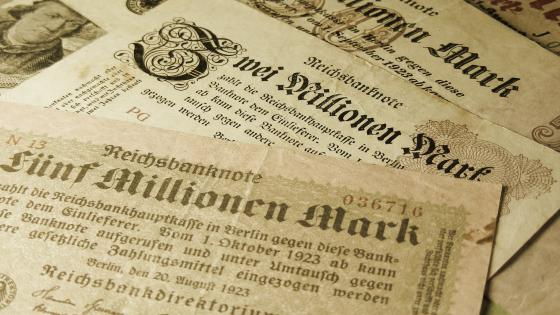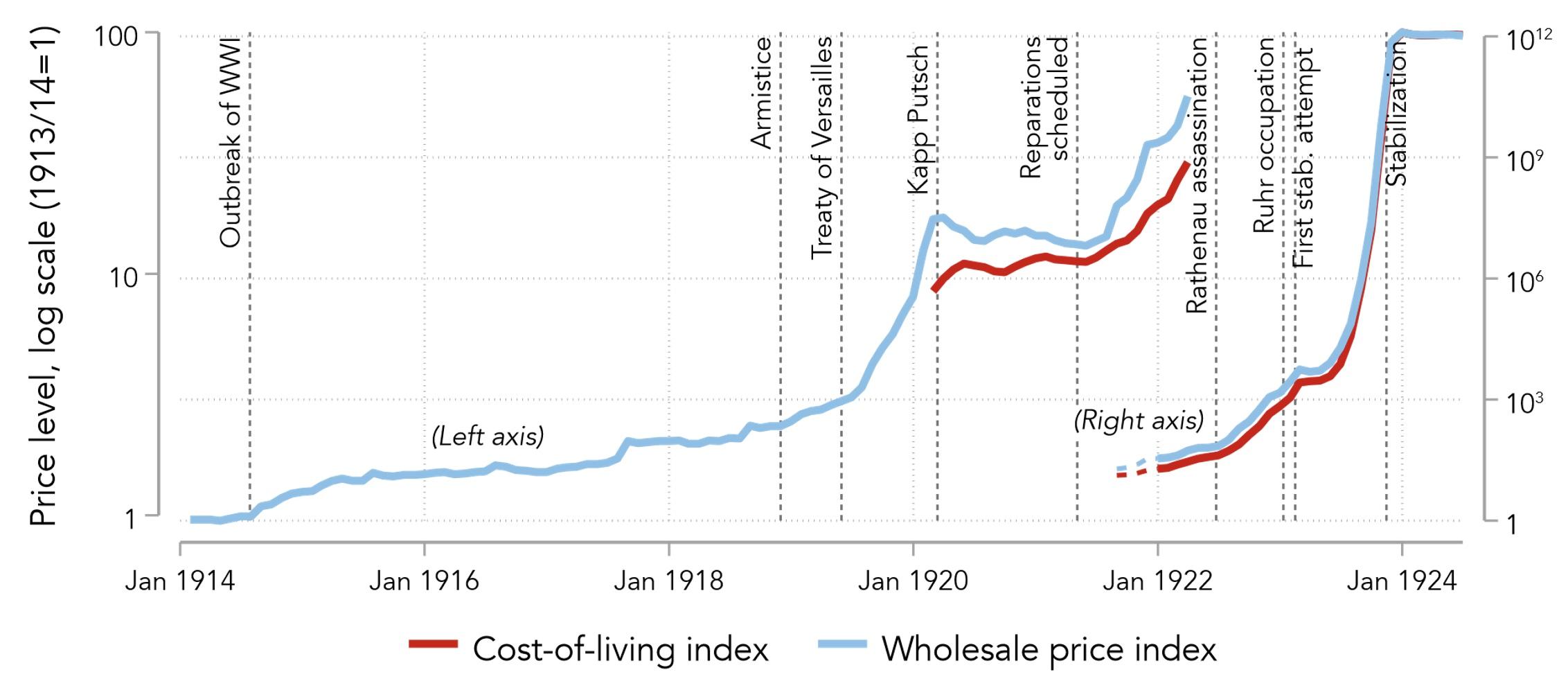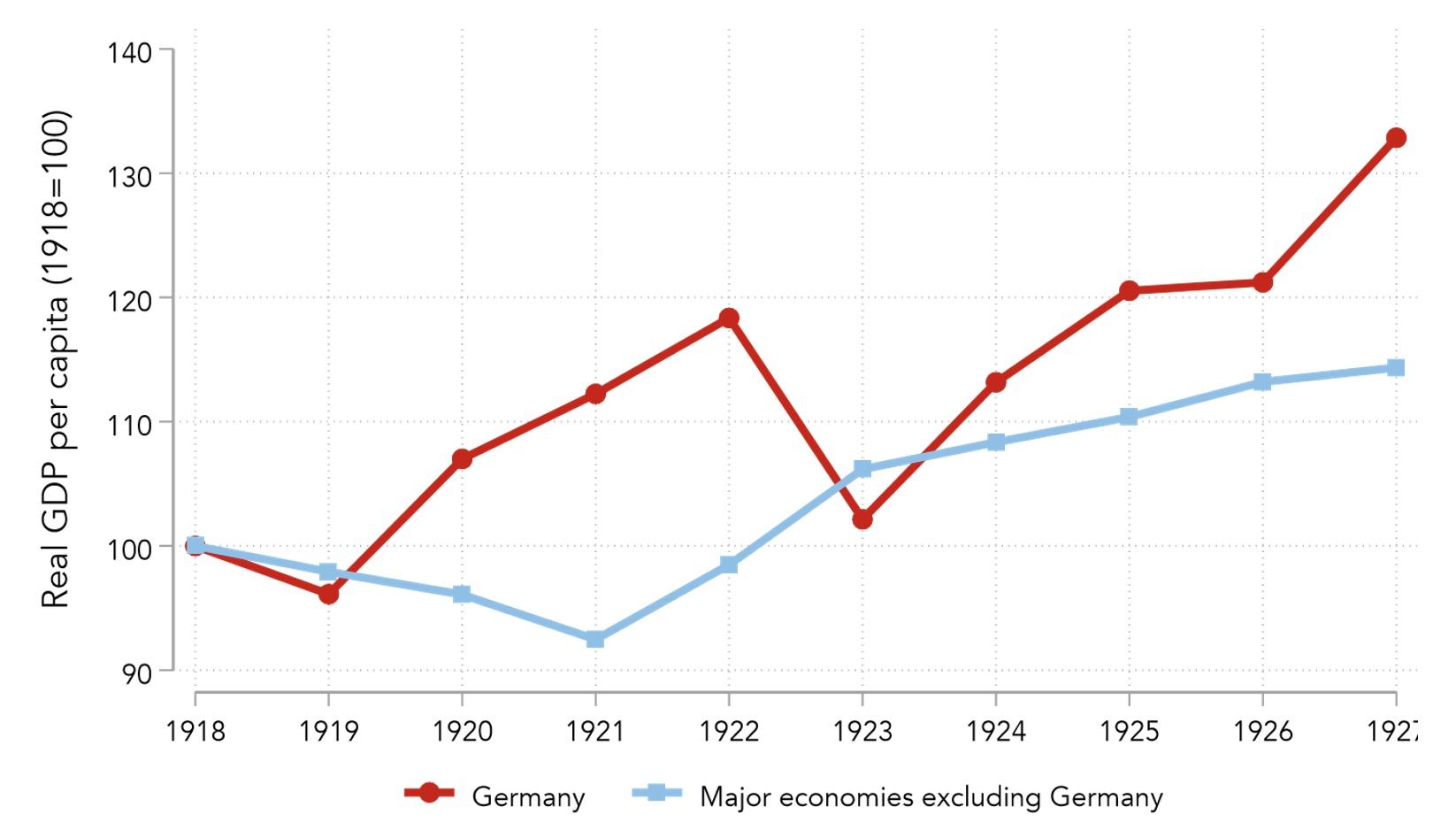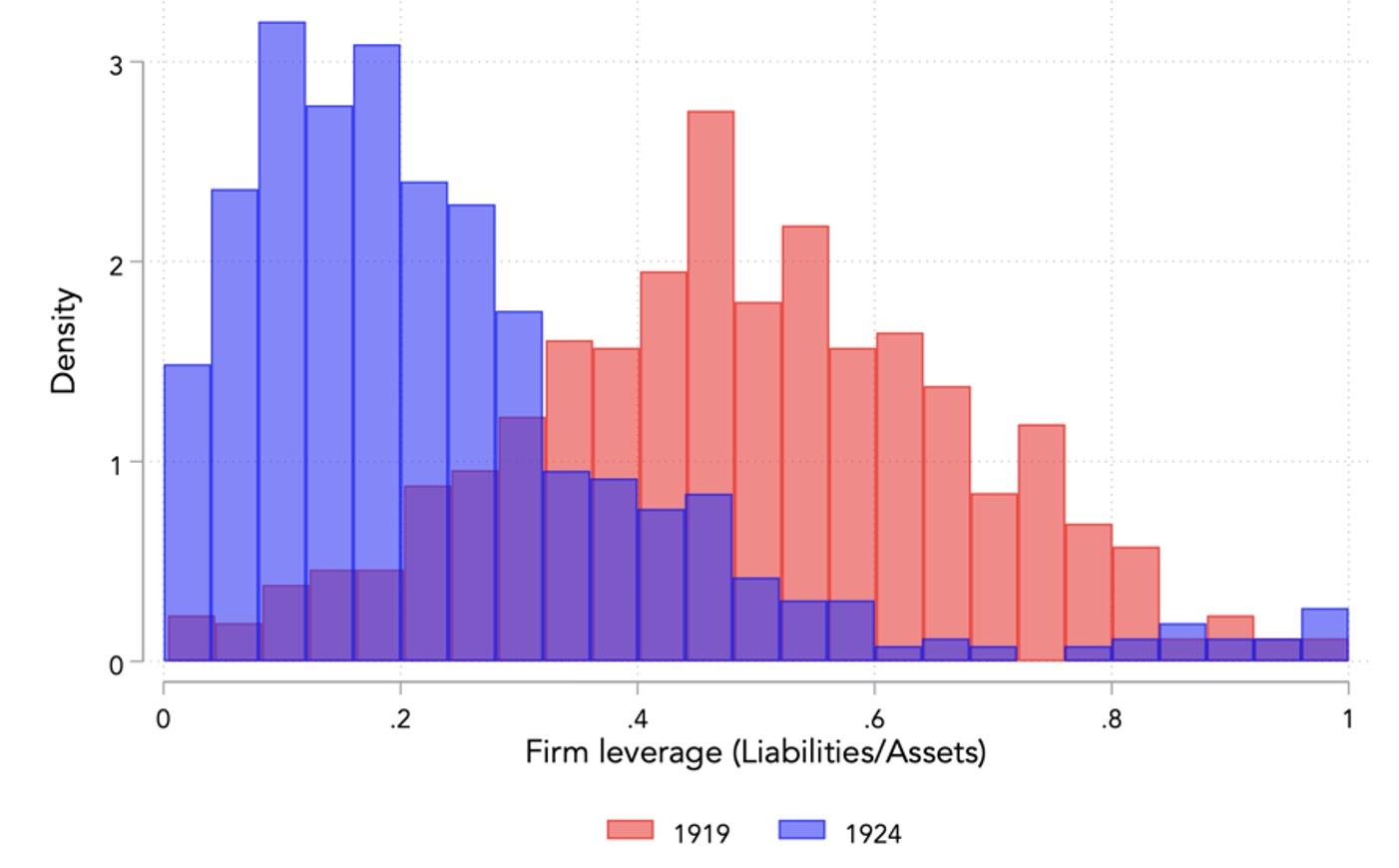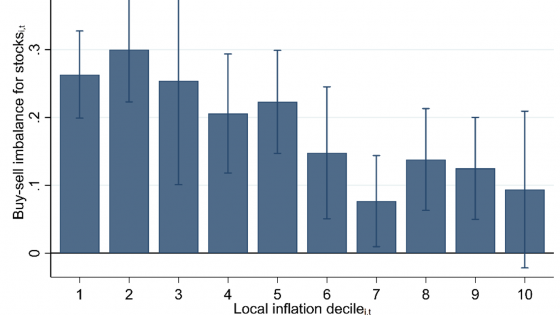The recent rise in price pressures around the world has reignited interest in understanding how inflation transmits to the real economy. At least since Keynes (1923) and Fisher (1933), economists have recognised that unexpected surges of inflation can redistribute wealth from creditors to debtors when debt contracts are written in nominal terms. If debtors are financially constrained, this redistribution can affect real economic activity by relaxing financing constraints. This mechanism, which we call the debt-inflation channel, is well understood theoretically (e.g. Gomes et al. 2016), but there is limited evidence limited empirical evidence to substantiate it.
Periods of elevated inflation provide a laboratory to study how high inflation is transmitted to the real economy. In this column, we discuss new insights from one of the key events in monetary history: the Great German Inflation of 1919-23. Because this case of inflation was both surprising and extremely high, Germany’s experience helps shed light on how high inflation impacts firms’ economic activity through the erosion of their nominal debt burdens. These insights are based on a recently released research paper (Brunnermeier et al. 2023).
The German (hyper)inflation
Germany’s bout of hyperinflation is a defining event in monetary history. From a value of 4.2 to the dollar on the eve of WWI, the mark depreciated to 4.2 trillion to the dollar by November 1923. This episode has fascinated generations of economists, who have studied it to understand both the causes and consequences of high inflation (e.g. Cagan 1956, Sargent 1982).
Germany’s inflationary spiral can be divided into two distinct phases. Figure 1 shows that evolution of the price level for both wholesale prices and the cost-of-living index. The first phase of the inflation, from November 1918 to June 1922, brought a substantial rise in the price level due to various factors, including deficit-financed war spending, massive WWI reparations, and political unwillingness to raise taxes and cut spending. The absence of a proactive central bank response exacerbated the inflation. Notably, data on the forward exchange premium and anecdotal evidence of foreign speculators betting on an appreciation of the mark suggest that inflation was largely unexpected during this phase. The second phase, from July 1922 to November 1923, was the hyperinflation phase. This phase begins after political turmoil over WWI reparations and the assassination of Walther Rathenau, the country’s prominent foreign minister. Hyperinflation is characterised by uncontrollable price increases and unanchored inflation expectations.
Figure 1 The price level during Germany’s inflation
Notes: This chart shows the evolution of the price level in Germany between January 1914 and June 1924. The cost-of-living index only available from February 1920 onwards. Due to the extreme changes in price levels, prices are reported in logarithms and over two axes, with the first phase of the inflation on the left axis and the second phase on the right axis. The source for the wholesale price index (Gesamtindex der Grosshandelspreise) and cost-of-living index (Lebenshaltung insgesamt) is Zahlen zur Geldentwertung in Deutschland von 1914 bis 1923.
Germany’s inflation was associated with a booming economy from 1919 through the middle of 1922, followed by a severe bust starting at the end of 1922. Figure 2 plots an index of annual real GDP per capita for Germany starting in 1918. For comparison, we also plot an index of average real GDP per capita growth for other major industrial economies. While those economies experienced declining output from tight monetary conditions, Germany's real GDP per capita rose by 20% from 1919 to 1922. Further, unemployment was low from the end of WWI until the last months of 1922. Germany's boom slows with the hyperinflation in the second half of 1922 and decisively reverses in early 1923, following the invasion of the Ruhr industrial region by France and Belgium. In 1923, Germany saw a large fall in real GDP, and unemployment rose to nearly 30%.
Figure 2 Real GDP in Germany and other major economies, 1918-27
Notes: This chart shows real GDP per capita for Germany and an index of other major economies. The series are indexed to 100 in 1918. The data are from Jordà et al. (2017) and Barro and Ursúa (2008). “Major economies excluding Germany” is an index of average real GDP growth per capita, weighted by lagged nominal GDP in U.S. dollars. The index is constructed using 15 countries with continuous coverage in the Jordà et al. (2017) database between 1914 and 1927 (Australia, Belgium, Canada, Denmark, Finland, France, Italy, Japan, Norway, Portugal, Spain, Sweden, Switzerland, the U.K., and the U.S.).
Empirical evidence of the debt-inflation channel
What are the macro-financial implications of inflation? To explore the empirical relevance of the debt-inflation channel, we construct a new firm-level database by digitising a contemporary investor’s manual with information on firms’ financial statements and employment. The data cover approximately 700 nonfinancial joint-stock firms in Germany. These data reveal that inflation massively devalued firms’ liabilities, resulting in a collapse in firm leverage. Figure 3 shows that leverage fell by over 50% between the start of the inflation in 1919 and the aftermath of the inflation in 1924.
Figure 3 Inflation wiped out firm leverage
Notes: This figure shows the distribution of firm book leverage (liabilities-to-assets) at the start of the postwar inflation in 1919 and in the aftermath of the hyperinflation in 1924.
The reduction in firms’ nominal liabilities significantly reduced the likelihood of financial distress for firms in Germany. Figure 4 plots bankruptcies against inflation, revealing a strong negative relation between the two variables. Bankruptcies consistently declined with rising inflation and remained at historically low levels, even with the economic tumult of 1923. The sharpest declines in bankruptcies happened in the first phase of high inflation, before the hyperinflation in 1922-23. During the hyperinflation, additional inflation only slightly reduced bankruptcies. Intuitively, once the price level has doubled several times within a few years, debts have already been wiped out, making bankruptcy increasingly unlikely.
Figure 4 Inflation and firm bankruptcies
Notes: This figure plots the number of firm bankruptcies in quarter t against realized inflation over the past four quarters from t − 4 to t. Inflation is calculated as the log change (times 100). Quarterly counts of firm bankruptcies are obtained from the Vierteljahrshefte zur Statistik des Deutschen Reichs Herausgegeben vom Statistischen Reichsamt. Inflation of wholesale prices as reported in Zahlen zur Geldentwertung. The thick lines represent quadratic fits, computed separately for each of the two stages of inflation.
To understand the impact of inflation on real economic activity at the firm level, we examine the cross-section of firms based on their leverage prior to the inflationary shock. Firms with higher leverage before the onset of inflation saw the largest reduction in real debt burdens. Therefore, if the debt-inflation channel affects real activity, then it should operate most strongly for these high-leverage firms.
The data support this hypothesis. We find that high-leverage firms experienced larger declines in interest expenses and relative increases in both book and market equity values. Moreover, these firms expanded their real activity. The chart below shows the employment dynamics for low, intermediate, and high leverage firms during the inflation. It shows that high leverage firms saw the fastest employment growth once inflation accelerated in 1919. In terms of magnitudes, the debt-inflation channel can account for the majority of the overall expansion in employment during the German high inflation episode.
Figure 5 Employment dynamics across low and high leverage firms
Notes: This chart presents the average cumulated growth of employment for firms in the bottom, middle, and top terciles of leverage. Leverage is defined as the average ratio of liabilities-to-assets over 1918-1919. Employment is indexed to 100 in 1918 for each group.
Wrapping up
By exploiting a newly digitised firm-level database, our research provides empirical evidence supporting the relevance of the debt-inflation channel in the transmission of unexpected inflation to the real economy. What are the broader implications of these findings? Can the debt-inflation channel be operative during times of moderate inflation?
The relevance of the debt-inflation channel depends on the structure of debt contracts. In cases where debt contracts are nominal, long-term, and denominated in domestic currency, the debt-inflation channel may be relevant even during more moderate bouts of inflation. The debt-inflation channel may also operate through households, especially in a context of fixed-rate, long-term mortgage debt, as suggested by Doepke and Schneider (2006), Cardoso et al. (2022), and Diamond et al. (2022). At the same time, for firms with floating-rate or foreign-currency debt, inflation may have neutral or even negative effects on heavily leveraged firms.
Other factors can also counteract the expansionary effects of the debt-inflation channel. One example is if monetary policy responds to rising inflation by increasing interest rates and tightening financial conditions. Another potentially important offsetting effect comes from the losers of the debt-inflation channel: creditors. An increase in inflation can erode bank equity and contribute to credit contraction that offsets the expansionary effect from reducing borrower debt burdens.
References
Brunnermeier, M K, S A Correia, S Luck, E Verner and T Zimmermann (2023), “The Debt-Inflation Channel of the German Hyperinflation”, NBER Working Paper No. w31298.
Cagan, P (1956), The monetary dynamics of hyperinflation, Studies in the Quantity Theory of Money.
Cardoso, M, C Ferreira, J M Leiva, G Nuño, A Ortiz, T Rodrigo and S Vazquez (2022), “The heterogeneous impact of inflation on households’ balance sheets”, Red Nacional de Investigadores en Economia Working Paper No.176.
Diamond, W, T Landvoigt and G Sanchez (2022), “Printing away the mortgages: Fiscal inflation and the post-covid housing boom”, Available at SSRN.
Doepke, M and M Schneider (2006), “Inflation and the redistribution of nominal wealth”, Journal of Political Economy 114(6): 1069–1097.
Fisher, I (1933), “The debt-deflation theory of great depressions”, Econometrica: Journal of the Econometric Society, 337–357.
Gomes, J, U Jermann, and L Schmid (2016), “Sticky leverage”, American Economic Review 106(12): 3800–3828.
Jordà, Ò, M Schularick, and A M Taylor (2017), “Macrofinancial history and the new business cycle facts”, NBER Macroeconomics Annual 31(1): 213–263.
Keynes, J M (1923), A tract on monetary reform, Cosimo Classics.
Sargent, T J (1982), “The Ends of Four Big Inflations”, in Inflation: Causes and Effects, NBER Chapters, pp. 41–98.
